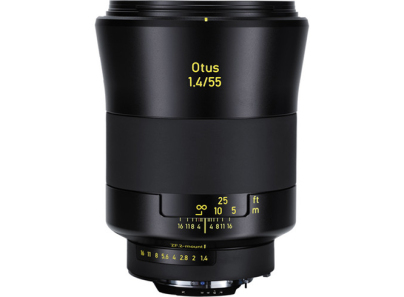
[ad_1]
The Zeiss Otus 1.4/55 ($3,990 list)($3,316.32 at Amazon)(Opens in a new window) is a fine example of a lens that makes no compromises. The 55mm f/1.4 manual focus optic, available for Canon and Nikon cameras, is perfectly sharp from edge to edge at all apertures, features an apochromatic design (so there’s no color fringing in images), and is capable of capturing a heck of a lot of light. But the lack of compromises come at a cost: The Otus is pretty big and heavy, doesn’t support autofocus, and is expensive compared with other SLR lenses. It’s still worthy of our Editors’ Choice award, based on its performance alone, but there are imperfect options available for less money.
The Otus measures 5.6 by 3.6 inches (HD) and weighs 2.1 pounds, heavier than some cameras to which you can mount it. A metal lens hood is included; it adds about 2 inches to the height of the lens when attached. The large front element supports 77mm filters. It’s available in a ZE version for Canon EOS cameras and an ZF.2 version for Nikon SLRs. The Nikon version of the lens has a physical aperture ring, but that’s unnceccessary for the Canon lens, as all EOS SLRs (35mm and digital) support electronic aperture control. The wide focus ring occupies a good portion of the barrel, and is covered with a hard rubber material. It’s a departure from the bare metal rings on other Zeiss SLR lenses, but I grew to like it. It’s not as cold to the touch, which is a boon for cold-weather shooting, and it offers enough grip for comfortable adjustments to focus. Behind it is the focus scale, in yellow, along with a depth of field scale with lines that mark full-stops from f/1.4 through f/16.
I was able to shoot with both the ZE and ZF.2 versions of the Otus. The sample images in the review were shot with the ZE lens and the Sony Alpha 7R($1,654.95 at Amazon)(Opens in a new window) via an adapter from Metabones, and Zeiss provided me with a ZF.2 version for sharpness testing, which I paired with the full-frame Nikon D800. Manual focus on a mirrorless camera like the Alpha 7R is a more pleasurable experience than the D800 with a stock focusing screen. The focus screens in modern D-SLRs are optimized for autofocus lenses, and don’t quite provide the precision that a split-prism screen in a vintage camera like the Nikon F3 offers. You can use Live View and magnification when time allows in order to achieve perfect focus. If you frequently use manual focus lenses, it’s wise to consider a third-party focus screen for your SLR; Canon sells one that is optimized for wide-aperture lenses, and both Canon and Nikon shooters can look to third-party sources for traditional split-image screens, some of which have additional aids like microprism collars.
Similar Products
I used Imatest (Opens in a new window)to check the sharpness of the Otus using a standard SFRPlus test chart. At f/1.4 it’s an outstanding performer, scoring 3,015 lines per picture height on a center-weighted test. That’s much, much higher than the 1,800 lines we require for a photo to be called sharp, and impressively the extreme edges of the frame are just as sharp as the center. It only gets better as you stop down: 3,265 lines at f/2, 3,602 lines at f/2.8, 3,829 lines at f/4, 3,899 lines at f/5.6, and 3,951 lines at f/8. Distortion is a nonissue; the lens shows 0.7 percent barrel distortion, but that’s barely relevant in field conditions. There’s no evidence of falloff at the corners; the vignette in the shot below was added in Lightroom.
Zeiss is no stranger to delivering impressive lenses. The Otus can be looked at as a premium version of one of the exceptions to that rule, the Planar T* 1,4/50($725.00 at Amazon)(Opens in a new window), a rare Zeiss lenses that is downright soft at its maximum aperture. The Zeiss-Makro Planar T* 2/50($1,283.00 at Amazon)(Opens in a new window) is a better lens if you want a high-quality manual focus lens without spending $4,000. It’s not inexpensive, but it’s an impressive performer that’s a feather weight compared to the Otus; but it only captures half the light at its maximum aperture.
The Otus 1.4/55 is an accomplishment. It’s as impressive an optic as the last lens that the company introduced, the excellent Apo Sonnar T* 2/135. Aside from the lack of autofocus, which is a design choice that allows for a smooth focus ring with a very long throw, the only real complaints with the lens are its size and weight. But a lens requires a lot of glass to capture images like the Otus does. If you’re the type of photographer who values image quality over all, the Otus is a dream lens.
4.5

(Opens in a new window)
(Opens in a new window)
View More
View More
The Zeiss Otus 1.4/55 is a no-compromise manual focus lens that makes no sacrifice in optical performance in deference to size, weight, or cost.
[ad_2]
Source link : https://www.pcmag.com/reviews/zeiss-otus-1455




